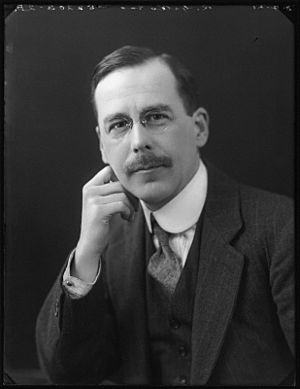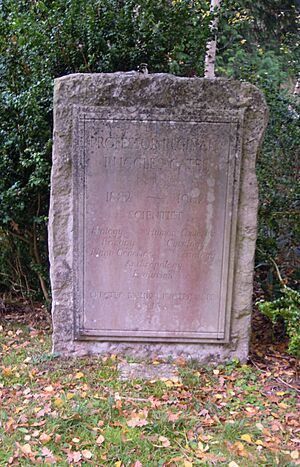Reginald Ruggles Gates facts for kids
Quick facts for kids
Reginald Ruggles Gates
|
|
|---|---|

Reginald Ruggles Gates in 1921
|
|
| Born | May 1, 1882 near Middleton, Nova Scotia, Canada
|
| Died | August 12, 1962 (aged 80) |
| Alma mater | Mount Allison University McGill University University of Chicago |
| Spouse(s) | Marie Stopes (1911–1914, annulled) Jennie Williams (1929, dissolved) Laura Greer (1955–) |
| Awards | Fellow of the Royal Society |
| Scientific career | |
| Fields | Spermatophytes, Oenothera |
| Institutions | King's College London |
| Author abbrev. (botany) | |
Reginald Ruggles Gates (born May 1, 1882 – died August 12, 1962) was a scientist from Canada. He studied genetics, which is the science of how traits are passed down from parents to children. He wrote many papers about plants (botany) and also about human heredity.
Contents
Early Life and Education
Reginald Ruggles Gates was born on May 1, 1882. His family lived near Middleton, Nova Scotia, in Canada. He also had a twin sister named Charlotte.
Gates was a very good student. He earned his first degree in science from Mount Allison University in 1903. He then started another degree at McGill University. During this time, he took a year off to work as a vice-principal at a school in his hometown.
He finished his second degree in 1905, focusing on botany, which is the study of plants. After that, he went to the University of Chicago. There, he earned his Ph.D. in 1908. His research was about how traits are passed down in a plant called Oenothera lata, also known as the evening primrose.
Career and Research
After finishing his studies, Gates worked on plants in Missouri in 1910. Later, he became a lecturer at Bedford College, London. He also became a Professor of Biology at King's College London. He was especially known for his work on Oenothera plants.
In 1931, Gates was chosen to be a Fellow of the Royal Society. This is a very important honor for scientists. His nomination mentioned that he was a "distinguished investigator" of how cells work. It also noted his important research on Oenothera, which helped scientists understand how plants change over time. He also taught many students who became important scientists themselves. Gates wrote over 100 scientific papers and several books.
Gates was also interested in how human traits are passed down. He wrote a book called Heredity and Eugenics in 1923. He continued to study human differences and heredity throughout his career. He helped start a journal called Mankind Quarterly. He also co-founded the International Association for the Advancement of Ethnology and Eugenics.
Personal Life
Reginald Ruggles Gates was married three times.
- In 1911, he married Marie Stopes, but their marriage ended in 1914.
- In 1929, he married Jennie Williams, but this marriage also ended later.
- In 1955, he married Laura Greer.
Death and Legacy
Reginald Ruggles Gates passed away on August 12, 1962. He was buried in Brookwood Cemetery in Surrey, England. To remember his contributions, Mount Allison University has an award named the Ruggles Gates Award.
Selected Publications
Gates wrote many books and articles during his career. Here are a few of them:
- Heredity and Eugenics. (1923). This book was about how traits are passed down in living things.
- Heredity in Man. (1929). This book focused on human heredity.
- A botanist in the Amazon Valley. (1927). This book shared his experiences studying plants in the Amazon.
- Human Genetics. (1946). This was a two-volume set about human genetics.
- Human Ancestry. (1948). This book explored the history of human populations.
- "Racial elements in the aborigines of Queensland, Australia". (Jan. 1960). This was an article published in a scientific journal.


